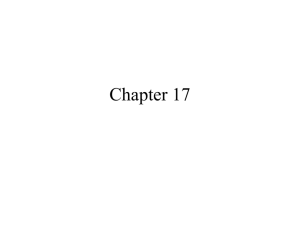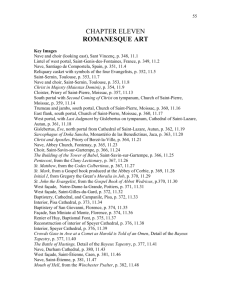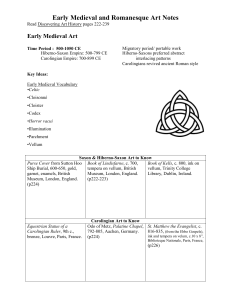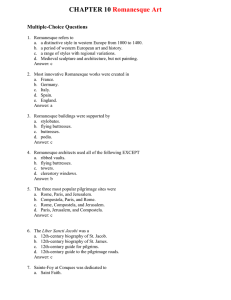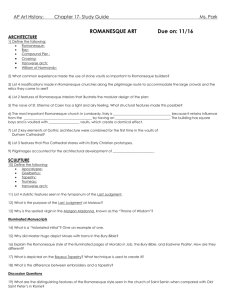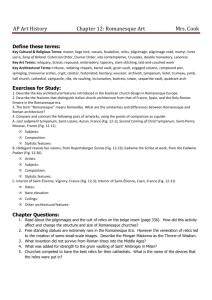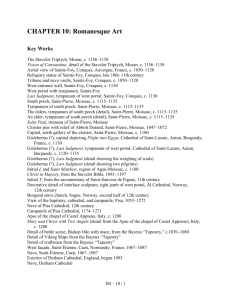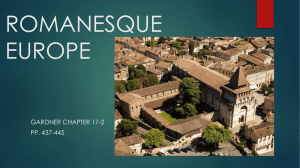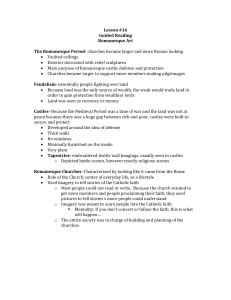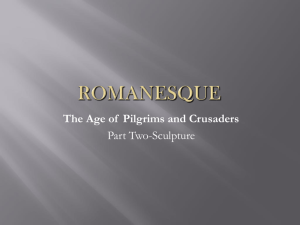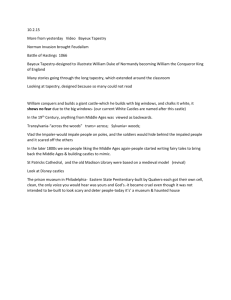Chapter 10 Test Bank
advertisement
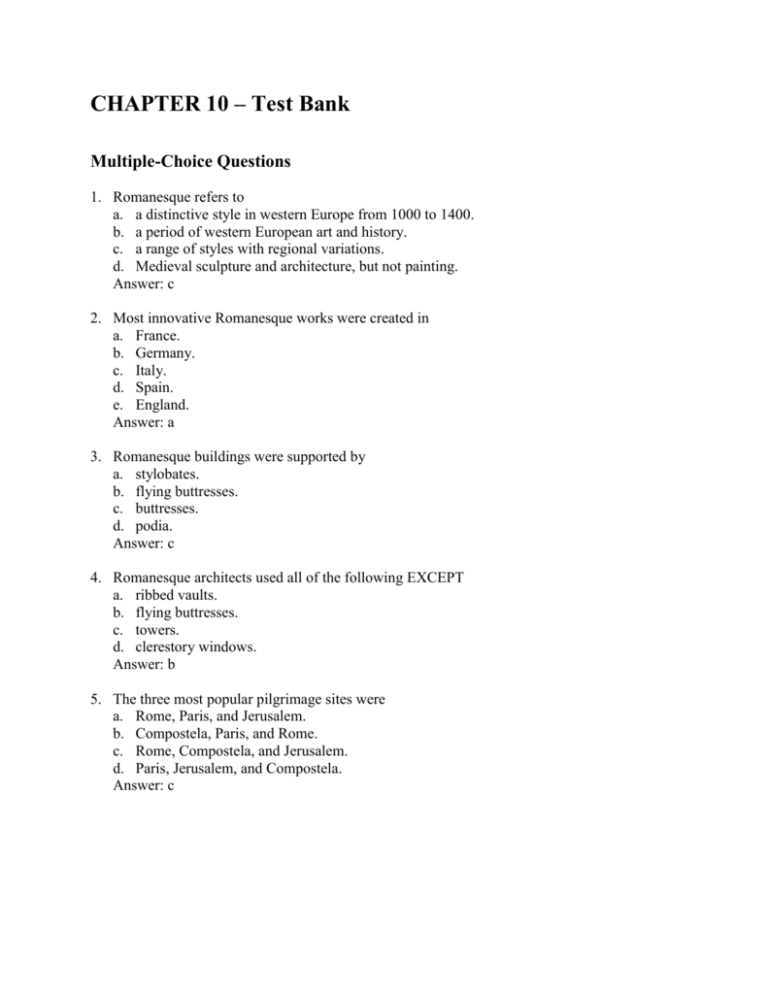
CHAPTER 10 – Test Bank Multiple-Choice Questions 1. Romanesque refers to a. a distinctive style in western Europe from 1000 to 1400. b. a period of western European art and history. c. a range of styles with regional variations. d. Medieval sculpture and architecture, but not painting. Answer: c 2. Most innovative Romanesque works were created in a. France. b. Germany. c. Italy. d. Spain. e. England. Answer: a 3. Romanesque buildings were supported by a. stylobates. b. flying buttresses. c. buttresses. d. podia. Answer: c 4. Romanesque architects used all of the following EXCEPT a. ribbed vaults. b. flying buttresses. c. towers. d. clerestory windows. Answer: b 5. The three most popular pilgrimage sites were a. Rome, Paris, and Jerusalem. b. Compostela, Paris, and Rome. c. Rome, Compostela, and Jerusalem. d. Paris, Jerusalem, and Compostela. Answer: c 6. The Liber Sancti Jacobi was a a. 12th-century biography of St. Jacob. b. 12th-century biography of St. James. c. 12th-century guide for pilgrims. d. 12th-century guide to the pilgrimage roads. Answer: c 7. Sainte-Foy at Conques was dedicated to a. Saint Faith. b. Saint Frederic. c. Saint Philobert. d. Saint Francis. Answer: a 8. A reliquary is a a. cinerary urn. b. medieval sarcophagus. c. container for relics. d. jeweled container. Answer: c 9. Which is NOT part of the plan of Sainte-Foy at Conques? a. a narthex b. a nave c. a transept d. a crossing e. an apse Answer: a 10. Which is NOT a feature of the typical Romanesque portal? a. voussoir b. tympanum c. lintel d. door jamb e. transept Answer: e 11. A refectory is a a. container for relics. b. monastery kitchen. c. monastery dining hall. d. mirror image. Answer: c 12. The iconography of the tympanum of the south porch of Saint-Pierre at Moissac has a visionary character because the abbey a. was inspired by a vision of St. Peter’s. b. was inspired by a dream of Clovis’s. c. was inspired by a miracle of St. Peter’s. d. was inspired by an oracle. Answer: b 13. The traditional apocalyptic symbols of the Evangelists are a. a bull, an eagle, a serpent, and a lion. b. a bull, a serpent, an eagle, and an angel. c. a serpent, a lion, an angel, and an eagle. d. an angel, a bull, an eagle, and a lion. Answer: d 14. Which is NOT true of the Stavelot reliquary? a. It is a triptych. b. It illustrates the Legend of the True Cross. c. It is located in Holland. d. It attracted pilgrims to Belgium. e. It was believed to contain a nail used in the Crucifixion. Answer: c 15. Which best describes the tympanum of Saint-Pierre at Moissac? a. The figures are elongated and stylized. b. The figures are frontal and elongated. c. The figures are naturalistic and patterned. d. The figures are elongated and are made of marble. Answer: a 16. Saint-Pierre at Moissac demonstrates a comprehensive sculptural program in a. its portal. b. its porch. c. its westwork. d. both its portal and its porch. Answer: d 17. The tympanum at Moissac shows a. the Last Judgment. b. Christ in Glory with the Elders of the Apocalypse. c. the Crucifixion. d. the Virgin and Child. Answer: a 18. The cleric who criticized the extravagant decoration of places like the cloister of St-Pierre, Moissac, was a. St. James of Compostela. b. St. Bernard. c. St. Francis. d. St. Benedict. Answer: b 19. The single sculptor at Autun has traditionally been associated with which of the following? a. Durand b. Gislebertus c. Jacobus d. No one knows. Answer: b 20. Examples of Romanesque style outside of France are found a. in Norway. b. at Pisa. c. in Belgium. d. at Castel Appiano. e. All these answers are correct. Answer: e 21. The Bayeux Tapestry is a. a tapestry. b. an embroidery. c. a Viking work. d. a parchment. Answer: b 22. The Bayeux Tapestry was probably commissioned by a. William the Conqueror. b. Gislebertus. c. Bishop Odo. d. the Norman Queen Mathilde. e. Harold of Saxony. Answer: c 23. William the Conqueror encouraged a. the building of churches in Normandy. b. the conquest of Anglo-Saxon England. c. the building of churches in England. d. All these answers are correct. Answer: d 24. Tall twin towers were integrated into the façades of Romanesque churches in a. Italy. b. England. c. the South of France. d. Normandy. Answer: d 25. Because the year 1000 suggested the end of time, Romanesque churches often showed the Last Judgment on a. the jambs. b. the tribune. c. the tympanum. d. the trumeau. Answer: c 26. The text on the Bayeux Tapestry is in a. French. b. English. c. Norwegian. d. Latin. e. Anglo-Saxon. Answer: d 27. The subject of the Bayeux Tapestry is a. the construction of Bayeux Cathedral. b. the Norman conquest. c. the Viking invasion of Europe. d. the Saxon invasion of Normandy. Answer: b
